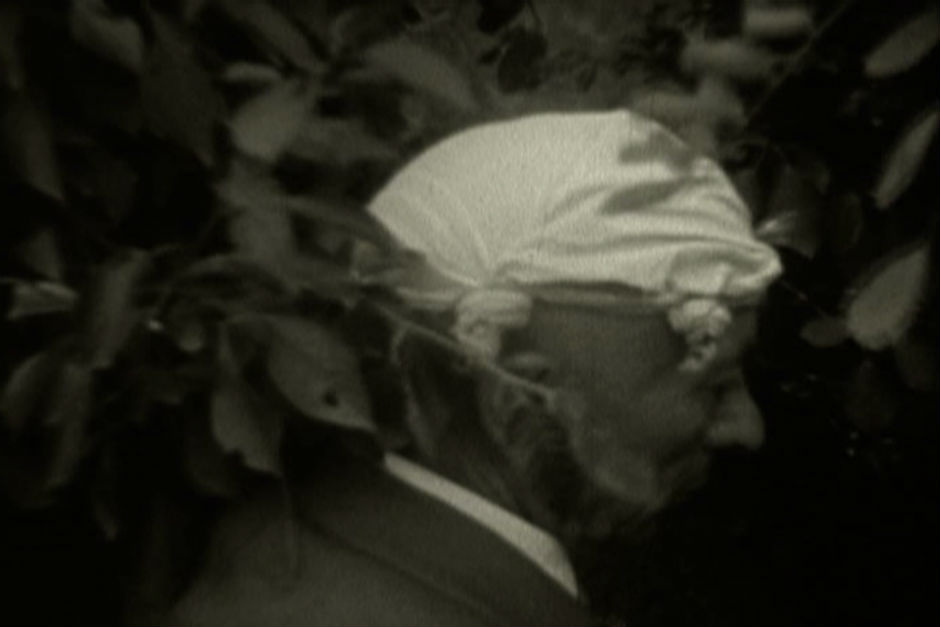Way Fare

Length: 6:30 mins
Year of production: 2009
Exhibition Format: Quicktime file
Source Format: 16mm found footage
Language: No language
Selected Music by: Giuseppe Iacono
Synopsis: A layered tone poem of found images and woven soundscapes renders a shifting psychogram; a nomadic passage across spaces in and out of time.
Statement: The underlying concept was to have a protagonist traverse various spaces on different levels: through visual, temporal, aural, psychological, physical, and perhaps cultural spaces. It was less important to me to communicate some specific story, i.e. “it’s about this person who came from and lives in…” but rather, I wanted to audio-visually translate a simultaneous movement through disparate spaces, e.g. past and present, here and there. There are different ways to look at this movement; there is a “person” who is seen, who sees, and whose perspective we see. Into this play of perspectives, I included a more remote angle, perhaps a deceased ancestor that one never personally knew, but heard stories of, someone who came from another country, and was of another time. For way fare, I was most interested in the affect itself. While way fare is not about a specific place that I can name (I wouldn’t be able to, since I don’t know where the various found, amateur footage was shot), this lead character has certain emotional responses when walking through a field. Different instances in the environment evoke different affects in the protagonist. His feelings are visualized by fleeting cameos, moments and gestures, intercut with what could be the environment he is in, but could also be related to reveries or memories. Past and present blur, making it impossible to know what comprises internal visions or “real time,” one isn’t even sure anymore which of the characters is supposed to be in the “present.” (San Francisco, October 2010. Sylvia Schedelbauer)
"It was only by following the course time prescribed that we could hasten through the gigantic spaces separating us from each other." W.G. Sebald, Austerlitz
–––Despite the presence and recurrence of a male figure walking across a muddy field at the beginning, middle, and end of way fare (2009), the footage, taken from educational and industrial films, seems more diverse and the overall effect more abstract than the previous works. This impression is compounded by faster editing and superimpositions, tending to blur and blend images temporally as well as spatially. A vague family resemblance prevails: trees, leaves, woods, farmers, tractors, rivers, a grasshopper eating a leaf, then being devoured by insects, emerging larvae—first accompanied by bird sounds and then by a distant buzz saw, which we see later resting on a tree trunk—might suggest that nature’s cycle is a unifying theme. But we also see vehicles moving along highways, people who seem to be migrating illegally via boats—and that lone walker who might just be the artist’s surrogate traveling consciousness, attempting to piece together the disparate places, times, and experiences that constitute an individual’s life. (Tony Pipolo, Artforum)
–––Similarly, with both [Remote] Intimacy (2007) and Way Fare (2009), she repurposes found footage – which she describes as, ‘an archive of impressions registered for no specific purpose but as reminders for later use’ – to invent a brilliant memoria composed of events one was never a witness to, places one has never visited, and people one may never meet (but which still seem familiar). In this, she crafts a deliberate conflation of personal memory with the cultural memory of specific media – films or shows that seem like we may have seen them, but whose name will slip us forever. There is however a grander purpose to this design than a mere observation of how the media we engage with can infuse itself in our veins; it is also to recognise and then declare our collective ownership of an archive of the eternal: we may not be sure of which films these are, but we know the sorrow that is their definition; we may not dress like the characters in them, but we mourn alike. In this, Schedelbauer institutes a monument to the fundamentally uncanny – material akin to our own lives, but not quite. (Anuj Malhotra, Senses of Cinema)
–––False Friends and way fare rely on a hypnotic, subconsciously suggestive combination of images, ones that can evoke semi-tangible meanings upon close, repeat inspection (e.g., Freudian “dream-work”), but in the actual viewing are slippery and terse, drawing only traces of their denotative meaning from the mind before their disappearance. (Michael Sicinski, Cinema Scope)
Awards:
2010 Award for best sound design, Ann Arbor Film Festival